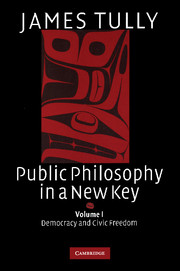Book contents
- Frontmatter
- Contents
- Acknowledgments
- Credits
- INTRODUCTION
- PART 1 APPROACHING PRACTICE
- 1 Public philosophy as a critical activity
- 2 Situated creatively: Wittgenstein and political philosophy
- 3 To think and act differently: comparing critical ethos and critical theory
- PART 2 DEMOCRACY AND RECOGNITION
- PART 3 INDIGENOUS PEOPLES
- CONCLUSION
- Bibliography
- Index to Volume I
- IDEAS IN CONTEXT
3 - To think and act differently: comparing critical ethos and critical theory
Published online by Cambridge University Press: 05 September 2012
- Frontmatter
- Contents
- Acknowledgments
- Credits
- INTRODUCTION
- PART 1 APPROACHING PRACTICE
- 1 Public philosophy as a critical activity
- 2 Situated creatively: Wittgenstein and political philosophy
- 3 To think and act differently: comparing critical ethos and critical theory
- PART 2 DEMOCRACY AND RECOGNITION
- PART 3 INDIGENOUS PEOPLES
- CONCLUSION
- Bibliography
- Index to Volume I
- IDEAS IN CONTEXT
Summary
INTRODUCTION
In this chapter I turn from Wittgenstein to Foucault and show the contribution his work has made to the approach I set out in Chapter 1. I do this by comparing and contrasting his work with the work of Habermas, just as I did with Wittgenstein. I do this for three main reasons. Firstly, like Wittgenstein, I think we come to understand some complex work best by comparing its similarities and dissimilarities with another closely related work. The works of Habermas and Foucault are closely related forms of historical and critical reflection on the present and thus are ideal for comparison. Secondly, Habermas and others raised four sorts of objection to Foucault's work and Foucault reworked his approach in ways that can be seen as responses. This thus enables me to put them in a dialogue by drawing out his responses and showing their cogency. Thirdly, this comparison is ideal for my purposes, for Foucault's responses are exactly the features of his work that I adapt in my public philosophy and its applications. The comparison thus provides, along with Chapter 2, the groundwork of the two volumes. I should add that I use Habermas' work comparatively because I take it to be exemplary of the major alternative tradition of political philosophy (Critical Theory) to the one I am explicating. I hold it in the highest regard.
- Type
- Chapter
- Information
- Public Philosophy in a New Key , pp. 71 - 132Publisher: Cambridge University PressPrint publication year: 2008
- 2
- Cited by

